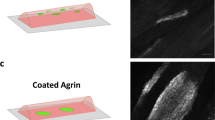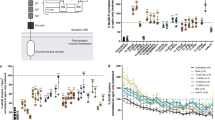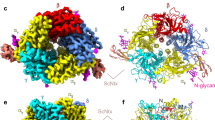Abstract
MuSK is a tyrosine kinase localized to the postsynaptic surface of the neuromuscular junction. We have searched for modulators of MuSK function using a library of human single chain variable region antibodies (scFv) that can be displayed on M13 phage or expressed as soluble protein. A panel of 21 independent MuSK-specific scFv, identified in a screen for binding to MuSK-Fc immunoadhesin, were examined for ability to induce proliferation in a factor dependent cell line (Ba/F3) through a chimeric receptor, MuSK-Mpl. Four of the scFv induced a proliferative response, suggesting an ability to induce dimerization of MuSK. These scFv were also able to induce tyrosine phosphorylation of full-length MuSK and retained this ability when re-engineered to be expressed as authentic (and dimeric) human IgG molecules. Addition of agonist scFv to a cultured myotube cell line induced AChR clustering and tyrosine phosphorylation. These results provide direct evidence that MuSK activation is capable of triggering a key event in neuromuscular junction formation and further demonstrate that large libraries of phage-displayed scFv provide a robust method for generating highly specific agonist agents.
This is a preview of subscription content, access via your institution
Access options
Subscribe to this journal
Receive 12 print issues and online access
$209.00 per year
only $17.42 per issue
Buy this article
- Purchase on Springer Link
- Instant access to full article PDF
Prices may be subject to local taxes which are calculated during checkout
Similar content being viewed by others
References
Valenzuela, D.M., Stitt, T.N., DiStefano, P.S., Rojas, E., Mattsson, K., Compton, D.L, et al. 1995. Receptor tyrosine kinase specific for the skeletal muscle lineage: Expression in embryonic muscle, at the neuromuscular junction, and after Injury. Neuron 15: 573–584.
Dechiara, T.M., Bowen, D.C., Valenzuela, D.M., Simmons, M.V., Poueymirou, W.T., Thomas, S., et al. 1996. The receptor tyrosine kinase MuSK is required for neuromuscular junction formation in vivo. Cell 85: 501–512.
Gautam, M., Noakes, P.G., Moscoso, L, Rupp, R, Scheller, R.H., Merlie, J.P., and Sanes, J.R., 1996. Defective Neuromuscular Synaptogenesis in Agrin-Deficient Mutant Mice. Cell 85: 525–535.
Glass, D.J., Bowen, D.C., Stitt, T.N., Radziejewski, C., Bruno, J., Ryan, T.E., D.R., et al. 1996. Agrin acts via a MuSK receptor complex. Cell 85: 513–523.
Kleiman, J. and Reichart, L.F. 1996. Testing theagrin hypothesis. Cell 85: 461–464.
Bowe, M.A. and Fallen, J.R. 1995. The role of agrin in synapse formation. Annu-Rev-Neurosci. 18: 443–462.
Godfrey, E.W., Nitkin, R.M., Wallace, B.G., Rubin, L.L., and McMahan, U.J. 1984. Components of Torpedo electric organ and muscle that cause aggregation of acetylcholine receptors on culture muscle cells. J. Cell Biol. 99: 615–627.
Nitkin, R.M., Smith, M.A., Magill, C., Fallon, J.R., Yao, M.Y.-M., Wallace, B.G., and McMahan, U.J. 1987. Identification of agrin, a synaptic organizing protein from Torpedo electric organ. J. Cell Biol. 105: 2471–2478.
O'Toole, J.J., Deyst, K.A., Bowe, M.A., Nastuk, M.A., McKechnie, B.A., and Fallon, J.R. 1996. Alternative splicing of agrin regulates its binding to heparin alpha-dystroglycan. Prac. Natl. Acad. Sci. USA 93: 7369–7374.
Cunningham, B.C., Ultsch, M., De-Vos, A.M., Mulkerrin, M.G., Clauser, K.R., and Wells, J.A. 1991. Dimerization of the extracellular domain of the human growth hormone receptor by a single hormone molecule. Science 254: 821–825.
Carter, S.C., Schwartz, J., and Smit, L.S., 1996. Molecular mechanism of growth hormone action. Annu-Rev-Physiol. 58: 187–207.
Gurney, A.L, Wong, S.C., Henzel, W.J., and DeSauvage, F.J. 1995. Distinct Regions of c-Mpl cytoplasmic domain are coupled to the JAK-STAT signal trans-duction and She phosphorylation. Prac. Natl. Acad. Sci. USA 92: 5292–5296.
Ruegg, M.A., Tsim, K.W., Norton, S.E., Kroger, S., Escher, G., Gensch, E.M., and McMahan, J.J. 1992. The agrin gene codes for a family of basal lamina proteins that differ in function and distribution. Neuron 8: 691–699.
Tsim, K.W.K., Ruegg, M.A., Escher, G., Kroger, S., and McMahan, U.J. 1992. cDNA that Encodes Active Agrin. Neuron 8: 677–689.
Rupp, F., Payan, D.G., Magill-Solc, C., Cowan, D.M., and Scheller, R.H. 1991. Structure and Expression of a Rat Agrin. Neuron 6: 811–823.
Kortt, A.A., Malby, R.L., Caldwell, J.B., Gruen, L.C., Ivanci, N., Lawrence, M.C. et al. 1994. Recombinant anti-sialidase single-chain variable fragment antibody. Characterization, formation of dimer and higher-molecular-mass multimers and the solution of the crystal structure of the single-chain variable fragment/siali-dase complex. Eur. J. Biochem. 221: 151–157.
Alfthan, K., Takkinen, K., Sizman, D., Soderlund, H., and Teeri, T.T. 1995. Properties of a single chain antibody containing different linker peptides. Protein-Eng. 8: 725–731.
Ferns, M.J., Campanelli, J.T., Hoch, W., Scheller, R.H., and Hall, Z. 1993. The ability of agrin to cluster AChRs depends on alternative splicing and on cell surface proteoglycans. Neuron 11: 491–502.
Griffiths, A.D., Malmqvist, M., Marks, J.D., Bye, J.M., Embleton, M.J., McCafferty, J., et al. 1993.Human anti-self antibodies with high specificity from phage display libraries. EMBO-J 12: 725–734.
Clackson, T., Hoogenboom, H.R., Griffiths, A.D., and Winter, G. 1991. Making antibody fragments using phage display libraries. Nature 352: 642–648.
Mark, M.R., Chen, J., Hammonds, G., Sadick, M., and Godowski, P.J. 1996. Characterization of Gas6, a member of the superfamily of G domain-containing proteins, as a ligand for Rse and Axl. J. Biol. Chem. 271: 9785–9789.
Author information
Authors and Affiliations
Rights and permissions
About this article
Cite this article
Xie, MH., Yuan, J., Adams, C. et al. Direct demonstration of MuSK involvement in acetylcholine receptor clustering through identification of agonist ScFv. Nat Biotechnol 15, 768–771 (1997). https://doi.org/10.1038/nbt0897-768
Received:
Accepted:
Issue Date:
DOI: https://doi.org/10.1038/nbt0897-768
This article is cited by
-
Development and characterization of agonistic antibodies targeting the Ig-like 1 domain of MuSK
Scientific Reports (2023)
-
Structural mechanisms of the agrin–LRP4–MuSK signaling pathway in neuromuscular junction differentiation
Cellular and Molecular Life Sciences (2013)
-
Beyond natural antibodies: the power of in vitro display technologies
Nature Biotechnology (2011)
-
Induction, assembly, maturation and maintenance of a postsynaptic apparatus
Nature Reviews Neuroscience (2001)
-
Human antibodies by design
Nature Biotechnology (1998)



